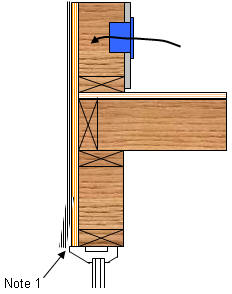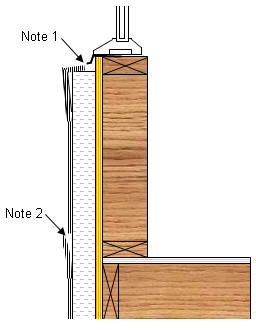Introduction:
Stucco is used in many parts of North America because it provides:
- Stucco has a great deal of design flexibility,
- Stucco has relatively high levels of envelope air-tightness,
- Stucco is a durable and maintenance-free exterior finish, when properly installed.
At the same time, the number of stucco-related problems experienced across North America shows a poor understanding of correct Stucco design and installation practices.
In virtually all parts of North America stucco installations are prematurely failing - almost always as a result of uncontrolled moisture movement through wall systems. Moisture that ends up trapped behind stucco - whether it is generated from the exterior or from the interior of the house - can result in rapid deterioration of the stucco finish and the tightness of the envelope which is designed to protect the structure of the home and its contents from damage..
As a general rule, the bulging and cracking of stucco veneer, as shown in Figures 49a and 49b, are the result of condensation of moist air that is leaking through the building envelope.
The two most common areas where the Stucco building envelope is broken is through the installation of electrical boxes on the inside of exterior walls and water and drainage pipes breaking through the interior walls to feed and drain plumbing fixtures.

Figure 49a - Common Stucco Defects - Inadequate water shedding

Figure 49b - Common Stucco Defects - Separation of stucco from lath
Note 1: The inadequate shedding of water around window and door openings results in a water build-up behind stucco.
Note 2: The separation of the stucco material from its lath, caused by water penetration through failed joints causes the stucco to pull away from the lath, bulging outward.
- Inadequate shedding of exterior rain or snow from around openings and penetrations in the stucco.
- Excessive moisture-loading on the stucco, either as a function of inadequate clearances from grade or roof materials, or as a result of moisture pooling on horizontal stucco surfaces.
- Penetration of rain and snow through openings in the stucco into the wall assembly.
- Trapping of moisture-laden interior house air in the wall assembly behind the stucco.
To a large extent, the problems reflect the weakness of systems designed with a face seal, where the major line of protection is subject to environmental deterioration and degradation. Without regular and effective maintenance, these systems are prone to leakage. Many designers also show a poor understanding of the need to properly drain the wall assembly in the event that moisture does accumulate behind the stucco.
